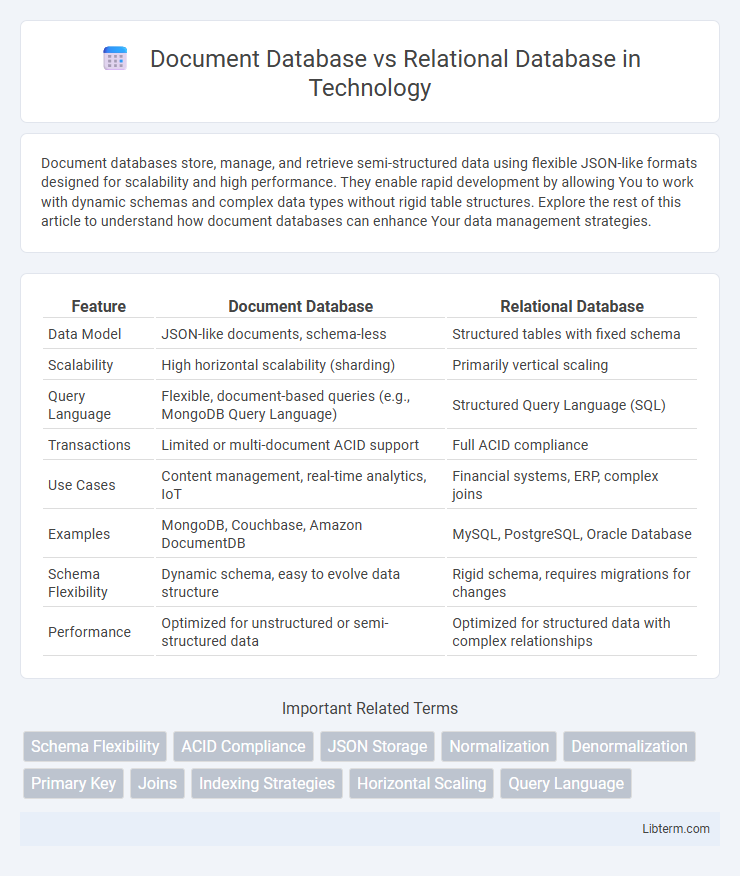Document databases store, manage, and retrieve semi-structured data using flexible JSON-like formats designed for scalability and high performance. They enable rapid development by allowing You to work with dynamic schemas and complex data types without rigid table structures. Explore the rest of this article to understand how document databases can enhance Your data management strategies.
Table of Comparison
| Feature | Document Database | Relational Database |
|---|---|---|
| Data Model | JSON-like documents, schema-less | Structured tables with fixed schema |
| Scalability | High horizontal scalability (sharding) | Primarily vertical scaling |
| Query Language | Flexible, document-based queries (e.g., MongoDB Query Language) | Structured Query Language (SQL) |
| Transactions | Limited or multi-document ACID support | Full ACID compliance |
| Use Cases | Content management, real-time analytics, IoT | Financial systems, ERP, complex joins |
| Examples | MongoDB, Couchbase, Amazon DocumentDB | MySQL, PostgreSQL, Oracle Database |
| Schema Flexibility | Dynamic schema, easy to evolve data structure | Rigid schema, requires migrations for changes |
| Performance | Optimized for unstructured or semi-structured data | Optimized for structured data with complex relationships |
Introduction to Database Types
Document databases store data in flexible, JSON-like documents, allowing for schema-less design and easy scalability, ideal for handling semi-structured or hierarchical data. Relational databases organize data into structured tables with fixed schemas, supporting complex queries through SQL and ensuring data integrity with ACID compliance. Choosing between these database types depends on application requirements such as scalability, flexibility, and query complexity.
What is a Document Database?
A document database stores data as JSON, BSON, or XML documents, allowing flexible, schema-less structures that easily handle complex and nested information. Unlike relational databases that use tables and rows with fixed schemas, document databases enable rapid development and scalability by organizing data into collections of documents. They are ideal for applications requiring dynamic data models, such as content management systems, real-time analytics, and mobile apps.
What is a Relational Database?
A relational database organizes data into tables with rows and columns, enabling structured query language (SQL) for complex queries and data manipulation. It relies on predefined schemas and relationships between tables through primary and foreign keys to maintain data integrity and ensure efficient transactions. Common examples include MySQL, PostgreSQL, and Oracle Database, widely used for applications requiring ACID compliance and consistent data models.
Data Structure Comparison
Document databases store data in flexible, JSON-like documents that allow nested objects and arrays, enabling complex, hierarchical data representation. Relational databases organize data into tables with rows and columns, enforcing structured schemas and Relationships via foreign keys for data integrity. Document databases excel in handling unstructured or semi-structured data, while relational databases are optimal for structured data requiring ACID compliance and complex joins.
Scalability and Performance Differences
Document databases excel in horizontal scalability by distributing data across multiple nodes, enabling efficient handling of large volumes of unstructured or semi-structured data. Relational databases typically scale vertically, which can limit performance and increase costs when managing complex, high-transaction workloads. The schema flexibility of document databases allows for faster read and write operations, enhancing performance in dynamic environments compared to the rigid schema and join operations in relational databases.
Query Flexibility and Language
Document databases offer query flexibility through dynamic schemas and support for nested, hierarchical data structures, enabling complex queries on semi-structured documents using JSON-like query languages such as MongoDB's query language. Relational databases use structured query language (SQL) with predefined schemas, providing powerful and standardized query capabilities optimized for structured and tabular data. Document databases excel in handling unstructured or varying data formats, while relational databases deliver precise and efficient queries for well-defined relationships and transactions.
Use Cases for Document Databases
Document databases excel in handling unstructured or semi-structured data, making them ideal for content management systems, real-time analytics, and e-commerce platforms requiring flexible schema designs. They support hierarchical data storage, which simplifies storing nested JSON or XML documents, perfect for mobile applications and user profile management. Their scalability and schema flexibility allow rapid development cycles and dynamic query capabilities, unlike relational databases that rely on fixed schema and complex JOIN operations.
Use Cases for Relational Databases
Relational databases excel in use cases requiring structured data with clear relationships, such as financial systems, customer relationship management (CRM), and inventory tracking. They offer strong ACID (Atomicity, Consistency, Isolation, Durability) compliance, ensuring reliable transaction processing and data integrity in complex queries. Industries like banking, healthcare, and enterprise resource planning (ERP) rely heavily on relational models for their robust schema enforcement and standardized SQL querying capabilities.
Pros and Cons of Each Database Model
Document databases offer flexible schema design, allowing storage of semi-structured data in JSON-like formats, which enhances scalability and rapid development for applications with evolving data requirements. However, they may lack strong ACID compliance and complex querying capabilities found in relational databases, limiting transactional integrity and multi-table joins. Relational databases provide robust data consistency, structured query language (SQL) support, and well-defined schemas optimal for complex transactions, though they can face scalability challenges and rigid schema evolution constraints in handling unstructured or rapidly changing data.
Choosing the Right Database for Your Needs
Document databases excel in handling unstructured and semi-structured data, offering flexible schema design ideal for applications requiring rapid development and scalability, such as content management and IoT data storage. Relational databases provide strong ACID compliance and structured query capabilities with predefined schemas, making them suitable for complex transactions and data integrity in financial systems and enterprise resource planning. Evaluate your application's data structure, scalability requirements, and consistency needs to choose between the schema-less flexibility of document databases and the strict relational model of relational databases.
Document Database Infographic

 libterm.com
libterm.com